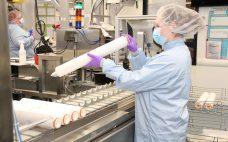Cytivaâs five-year manufacturing growth strategy includes expanding facilities and 24/7 shift patterns to support continued double-digit biopharma growth and a COVID-19 tailwind In April, Danaher Corporation completed its $21 billion acquisition of General Electricâs (GEâs) Healthcare Life Sciences business and five months later the division â renamed Cytiva â has laid out an aggressive growth strategy to deal with demand for its bioprocess equipment and services. âCytiva is deploying a multi-pronged approach to expand our global manufacturing capacity,â Emmanuel Ligner,…

Upstream & Downstream Processing
Automation: âThe only way to truly scale cell therapy manufactureâ says Lonza
Lonza says it has achieved a significant milestone with partner Sheba Medical treating its first patient with a CD19 CAR-T cell immunotherapy made using the automated point-of-care Cocoon technology. In March 2019, Swiss CDMO Lonza entered a partnership with Israelâs Sheba Medical Center to provide automated and closed CAR-T manufacturing using its point-of-care (POC) Cocoon cell therapy manufacturing platform. This week, Sheba and Lonza announced the first patient has been dosed with a CD19 CAR-T cell immunotherapy made using the…
MilliporeSigma adding 160 jobs to expanded NH filtration plant
MilliporeSigma will run a recently expanded facility in Jaffray, New Hampshire on a 24-hour cycle due to increased demand for filtration devices and membranes, driven in part by COVID-19. In June 2019, MilliporeSigma â the bioprocessing business unit of Germanyâs Merck KGaA â announced plans to expand its site in Jaffrey, New Hampshire. The site produces a variety of filtration devices and membranes that support the life science industries and the manufacture of biopharmaceuticals. The 35,800 additional square feet of…
Proteinea using fly larvae as âmini-bioreactorsâ in challenge to industry
Producing recombinant proteins in fly larvae instead of single-cell technologies could reduce biomanufacturing costs by up to 90%, says bioprocess startup firm Proteinea. Proteinea, a US and Egyptian startup, is looking to change the economics of biomanufacturing. The firm challenging the standard of using stainless-steel or single-use bioreactor systems to produce biologics by instead leveraging its insect-based biotechnology platform. Rather than produce a recombinant protein in single bacteria, yeast or mammalian cells, the firm uses InsectaPro, its platform comprising of…
Astrea buys filtration firm ELS and hints at more acquisitions
Astrea Bioseparations has acquired Essential Life Solutions (ELS) adding a chromatography column portfolio and operations in the US. The deal, financial details of which have not been divulged, closed last week bringing Astrea the SNAP brand of chromatography column products for research and small-scale purification of biological products. âSNAP columns are high precision, glass columns used with HPLC/FPLC systems for development of purification processes and lab scale chromatography,â Astrea told this publication. The range will complement Astreaâs bioprocess offering, which…
PendoTECH looks to compact photometer for post-filtration turbidity measurements
PendoTECH has upgraded its single use turbidity measurement system to improve performance, dynamic range, and overall usability Turbidity is the relative clarity of a liquid as the result of suspended solids in the liquid. Turbidity measurements typically use a beam of light to detect the presence of particles by measuring the difference between the amount of light that is emitted from a light source and the amount that is received by a detector. Measurements are affected by the size, shape,…
New technologies can solve downstream bottlenecks says expert
Biopharma needs to embrace new downstream processing technologies to overcome its manufacturing issues, according to an expert. Industry is reluctant to adopt new downstream technologies because firms prefers systems with which staff are familiar, said Alois Jungbauer from the Austrian Centre of Industrial Biotechnology at the University of Natural Resources and Life Sciences. He began by asking delegates at the BPI Europe virtual conference in July: âWhy is chromatography so popular? âItâs the high selectivity. Itâs the high resolution. We…
Cold play: Cryoport buying temperature-controlled logistics firm CRYOPDP
The âŹ49 million ($58 million) deal ups Cryoportâs logistics services, filling out its global offering to support cell and gene therapies as well as other life science functions. French logistics firm CRYOPDP has over 220 employees in 22 global facilities across 12 countries, supporting the life sciences industry through temperature-controlled logistics products and services. The all-cash âŹ49 million transaction, expected to complete in the next two months, will see the firm incorporated into Cryoport, expanding the firmâs global footprint and…
Automation can help biopharma enjoy the benefits of continuous processing says CPI
Automation can eliminate downstream bottlenecks and help pharma cut costs says the team behind a continuous downstream processing system at the UK Centre for Process Innovation. Manufacturing biopharmaceutical is a complex, time consuming and costly process. Most products are produced in batches â production runs through a series of steps and then ends. Batch production is reliable and able to make consistent product. However, it can be slow and expensive according to Stuart Jamieson, head of research at the CPI,…
The CHO must go on? Bioinformatics and gene editing reshaping cell line dev
Computational analysis and gene editing will yield CHO cells able to make protein drugs, faster and more cheaply says expert. The ability to turn cells into protein production âfactoriesâ is the foundation of modern biopharma according to Bjørn Voldborg, director of CHO cell line development at the Technical University of Denmark. âIf you want to engineer a factory [cell line] you need to understand what machines you have in the factory. Itâs the genome sequences of the CHO cells â…










